Alfred Turner (sculptor)
Alfred Turner RA (28 May 1874 – 18 March 1940)[1] was an English sculptor in the early 20th century. Among other institutions, Turner studied at the Royal Academy, where he exhibited and was a member. He was also a member and fellow of the Royal Society of British Sculptors.
Alfred Turner | |
|---|---|
 Queen Victoria Memorial in Endcliffe Park, Sheffield | |
| Born | 28 May 1874 London, England |
| Died | 18 March 1940 (aged 65) London, England |
| Nationality | English |
| Education | South London Technical Art School, Royal Academy Schools |
| Known for | Sculpture |
His sculptural works included statues, reliefs and war memorials. Some of his notable works included several statues of Queen Victoria, the Fishergirl and Fisherman at Fishmonger's Hall in London and war memorials in England, Wales and the Channel Islands. His daughter was also a distinguished sculptor.
Personal life
Turner was born on 28 May 1874, the son of sculptor C.E. Halsey-Turner. In 1899 he married Charlotte Ann Gavin and they had two daughters. One daughter, Winifred, became a distinguished sculptress.[2] He died in London on 18 March 1940.[3]
He first studied at, what was then called, the South London Technical Art School in Lambeth at a time when William Silver Frith was the modelling master. He then studied at Royal Academy Schools, having enrolled in 1895. He was there for three years during which time he was awarded in 1897 both the Gold Medal and Travelling Scholarship, worth £200. He studied for a period on the Continent and worked as an assistant in the studio of Harry Bates.[2]
Career
Turner taught sculpture at the London County Council (LCC) Central School of Arts and Crafts in Southampton Row, Holborn in 1907.{[1]
He exhibited at the Royal Academy from 1898 to 1937, became an Associate in 1922 and a full member in 1931. Turner was one of the early members of the Royal Society of British Sculptors and was a Fellow of that Society from 1923 until 1940.[2][3]
In 1988 the Ashmolean Museum in Oxford held an exhibition of the works of Alfred Turner and his daughter Winifred.[2]
Notable commissions
Fishmonger's Hall
In 1901 he exhibited a marble statue entitled Fisher girl; for a niche at the Royal Academy, and in 1902 this work, with its companion piece, Fisherman, was subsequently placed in the staircase niches of Fishmonger's Hall in London. Turner was given the commission to sculpt the two figures in 1899 when the hall was being redecorated. He received the commission based on the recommendation of William Silver Frith and was paid around 600 guineas for each statue.[2][3]
Statue of Queen Victoria
After the success of "Fishergirl", Turner secured commissions for three public monuments in bronze of Queen Victoria who died on 22 January 1901.
- Delhi, India
One was for Delhi and was unveiled by the Lieutenant-Governor of Punjab on 26 December 1902. Turner showed a bronze statuette of this work at the Royal Academy in 1903. Sadly the crown and the small statuettes representing "Justice" and "Peace", which were positioned on either side of the Queen's head were subsequently removed by vandals in 1905 when the statue was in India. Today this statue is to be found at the College of Art, Tilak Marg, in Delhi.[2]
- Tynemouth, England
Another copy of the Queen Victoria statue was made for Tynemouth in north east England.[4]
- Endcliffe Park, Sheffield, England
The third statue was for Sheffield, a complex, greater than life-sized composition that figures of a mother and her children with a Sheffield workman. It was originally erected in 1905 at Fargate, Sheffield but may now be found in Sheffield's Endcliffe Park.[5] The mother and workman are depicted in Maternity and Labour, both shown at The Royal Academy in 1904. The statue has reliefs representing Courage, in the form of a Crusader, with Justice and Truth. Another includes images of the Queen and St George.[2]
Turner was praised for his work. The statues were likened to Rodin's "Le Penseur" and the works of George Frederick Watts. Additionally it was stated that "Maternity is the best work by an outsider that the Academy has housed for many a year".[3][nb 1]
 Queen Victoria, "Maternity"
Queen Victoria, "Maternity"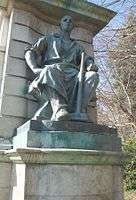 Queen Victoria,"Labour"
Queen Victoria,"Labour" Queen Victoria
Queen Victoria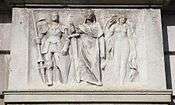 Relief on Queen Victoria Statue
Relief on Queen Victoria Statue
War memorials
| Work | Image | Location | Notes and References |
|---|---|---|---|
| E.R. Mobbs Memorial |  |
Northampton Northamptonshire | The E.R. Mobbs DSO Memorial in Memorial Garden in Abington Square, Northampton, Northamptonshire was moved to the present site in 1937 when the garden was opened. The inscription reads The memorial comprises a tapering pillar on a three stepped base. On the top of the pillar is a robed female figure representing the "Goddess of Fame" who holds a wreath in her left hand and a raised staff in her right. On the front face of the pillar there is a bust of Lt. Col. Mobbs and on the left side is a relief panel depicting a rugby match whereas on the right side another relief panel features a battlefield scene. The memorial was unveiled in July 1921 by Lord Lilford. All sculptural work was carried out by Turner.[2][6] Since 1921 an annual rugby game, called the "Mobbs Memorial Match", is played between the East Midlands and the Barbarians (Bingley). Before the game there is a short ceremony and a wreath is laid at the memorial.[2][6] Photograph courtesy J.A. Thorpe. |
| Fulham War Memorial | Fulham London | The Fulham War Memorial[7] is located at Vicarage Gardens, Fulham, London. This first stood in Fulham Palace Road where it was unveiled in July 1921 but it was moved to Vicarage Gardens in 1934. The central feature of this memorial is a bronze female figure said to represent "Glory to the dead". This figure holds a sword in one hand and a laurel wreath in the other. The memorial comprises a three stepped stone base upon which is a column of stone with a low shelf holding a statue of a cherub who kneels before a cross. On top of the column is the bronze female figure. The inscription reads The founders were Parlanti's Ltd. Turner described the Fulham Memorial as follows: "In it I aimed firstly, that it should be essentially a Memorial to the fallen men, and not in any sense merely a monument to Victory. Secondly, that it should have a Spiritual significance. The surmounting figure on the cenotaph represents Glory to the Dead, holding the torch of Freedom for which they died. The sorrowing Love on the Shrine at the base, will, I think, appeal to all who have lost dear ones in the War. The symbol over the Cross is an old Celtic sign for the Voice or Presence of God". The unveiling ceremony was led by ex. Army Chaplain who was the Minister of the Dawes Road Baptist Church named The Rev. H.G. Doel. He saw active service on the Western Front.[3] | |
| Kingsthorpe War Memorial |  |
Kingsthorpe Northamptonshire | Turner carried out the sculptural work on the Kingsthorpe War Memorial in Northampton, Northamptonshire. Here the memorial comprises a stone cenotaph on the top of which is a bronze figure of St George holding out a sword combined with a crucifix. There are bronze panels on each of the four sides. The inscription reads The figure is very similar to Sir Galahad which appears on the Turner work in Victoria College, Jersey, and was exhibited at the Royal Academy in 1923.[8] |
| Radyr War Memorial | Radyr South Glamorgan Wales | Turner carried out the sculptural work for the Radyr War Memorial in Heol Isaf, Radyr, South Glamorgan in South Wales. The same bronze figure and kneeling cherub is on the top of this memorial is like that at Fulham except that one hand holds a torch rather than a sword. The inscription reads Photo of bust of Edgar Mobbs is courtesy J.A. Thorpe. | |
| South African War Memorial | 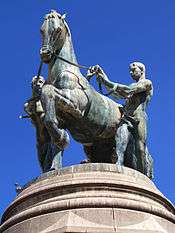 |
Cape Town, South Africa | Turner's composition "Dioscuri" |
| Victoria College War Memorial | 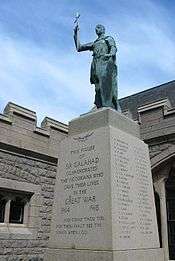 |
Jersey Channel Islands | Turner carried out the sculptural work for the War Memorial at Victoria College, Jersey. This was unveiled on 25 September 1924. It comprises a statue of Sir Galahad and is inscribed After the inscription is a quotation from Tennyson's "Holy Grail": "And come thou too, For thou shalt see the vision when I go". The memorial gives the name of the 126 men who gave their lives. The lettering was the work of Mr.F.Huaut.[10] Photograph courtesy Man Vyi |
| Winchester College War Cloister | Winchester Hampshire | Turner provided sculptural work for Sir Herbert Baker's War Memorial in the Winchester College War Cloister. Turner's contribution involved a Latin Cross on either side of which is a figure of St George who holds a broad sword on which a crucifix has been carved. At St George's feet is a slain dragon.[11] |
List of works
| Work | Image | Location | Notes and References |
|---|---|---|---|
| Castor and Pollux with horse statue | Delville Wood France | Turner was selected by Sir Herbert Baker to execute the Castor, Pollux and Horse sculpture on the South African War Memorial at Delville Wood in the Somme region of France and this led to his participation in the Cape Town and Pretoria War Memorials. See Delville Wood South African National Memorial.
A plaster cast of "Dioscuri", the title of Turner's work was shown in the forecourt of Burlington House in 1925 before the bronze was despatched to France the next year and unveiled on 10 October 1926 by the widow of General Botha. Two full-size bronze replicas went to South Africa in April 1928, one being erected in front of Capitol Buildings in Pretoria and the other in Cape Town. A bronze model was also placed in the Queen's Hall of the South African Houses of Parliament. 10 October was chosen as the unveiling date as this was the date in 1899 when the first shot was fired in the South African War and the date in 1908 of the National Conference which brought the Union of South Africa into being. In file TGA 8713.1.7 at Tate Britain Archive there is a copy of the unveiling ceremony programme of Sunday 10 October 1926. This describes the bronze sculpture as follows: “The stone dome which crowns the monument supports a group in bronze of two men representing Physical Energy and the two races of South Africa, between them leading a war horse into battle, and with one hand clasped over the horse's back. The group was inspired by the Greek sculpture of the twin gods Castor and Pollux and their horses guarding the steps of the Capitol at Rome, and by the legend of the great twin brethren who came overseas to fight in the ranks of Rome”. Also in the Archives are file TGA 8713.1.8. “The Delville Wood Memorial Book” in which one can read the text of some of the speeches made including that of Marechal Joffre who represented France and that of Field Marshal Earl Haig and file TGA 8713.1.9 which contains the final report of the South African National Memorial (Delville Wood) Committee of July 1931.[3] | |
| Cycle of Life | Not known. | The bronze panel entitled “Cycle of Life” exhibited at the Royal Academy in 1913.[3] | |
| "Dreams of Youth" | The Royal Academy Piccadilly London | Turner's composition "Dreams of Youth" is in the Royal Academy's permanent collection. This was in fact accepted by the Royal Academy as Turner's Diploma Work. In Tate Britain Archives' files is a letter dated 13 January 1932 announcing this and another letter dated 25 February 1932 signed by the King and agreeing to it[3][12] | |
| Old Bailey reliefs | Old Bailey London | Another early commission in 1905 to 1906 was work for the new Central Criminal Court/Old Bailey building. He produced three bas-reliefs in Portland stone, these illustrating the quotation from Psalm 72-"Defend the children of the poor. Punish the wrong-doer".The reliefs are positioned inside the main entrance. The panel on the left side features an angel, her sword drawn to protect a woman and her children (the defence of the children of the poor) and that on the right shows a warrior who has slain a dragon and holds a severed head (punishing the wrongdoer). At his side a woman holds his shield. In the central panel another angel holds a globe and points downwards towards the building's main entrance. She is flanked by "Spring", who sews seed from a basket and "Autumn" who holds a sickle and a sheaf of wheat. Perhaps this is meant to shown how "Justice" is active throughout the year. Need reliable citation. Turner also designed some metal grills for New Sessions House (leaf-like clouds, a sun burst and a nude infant crowned by child angels)[3] | |
| Owain Glyndŵr | 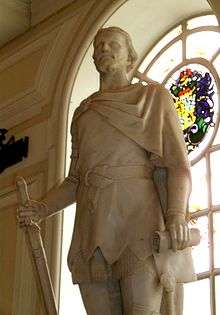 |
Cardiff Wales | Turner was one of the ten sculptors selected by the Royal Society of Sculptors to work on the statues of Welsh heroes in Cardiff's new City Hall. Turner sculpted, in Serrvezza marble, the statue of Owain Glyndŵr. This was unveiled by Lloyd George in October 1916. See image below.[2] |
| "Psyche" | Tate Britain London | The marble statue “Psyche" dating from 1918–1919 was purchased in 1921 by the President and Council of the Royal Academy under the terms of the Chantrey Bequest. This is now in Tate Britain.[3][13] | |
| St George sculpture | Whereabouts unknown | Turner made a St George slaying the dragon which was cast for use as a mascot for Lord Dureen's Rolls-Royce in 1927 | |
| Memorial to John Constable | The City London | The Memorial to John Constable in the crypt of St Paul's Cathedral is a work by Turner and dates from 1936 It was commissioned by the Leighton Fund./Royal Academy of Arts. Turner completed the work so that it would be ready for erection in time for the Centenary of Constable's death (1 April 1937). In the Tate Gallery Archives there is a letter from W. Godfrey Allen F.R.I.B.A. Surveyor to the Fabric. Surveyor's Office. St Paul's dated 15 June 1936. Godfrey Allen writes- "If I may say so I consider it the most beautiful design for a memorial which has been submitted for many years.”[3][14] | |
| Statue of King Edward VII | Faisalabad Pakistan | Turner sculpted the King Edward VII Memorial at Lyalipur in India(pre-partition names). Lyalipur is modern-day Faisalabad in Pakistan. It is not known if the work is still there.[2] | |
| "The Hand" | Tate Britain London | His sculptured group "The Hand" dating from 1936 was also purchased by the administrators of the Chantrey Bequest. In file TGA 8713.1.11- Correspondence, in the Tate Britain Archive there is a letter dated 30 April 1936 from the Royal Academy announcing the decision to purchase "The Hand" for £850.[3][15] | |
| "Mother and Child" | 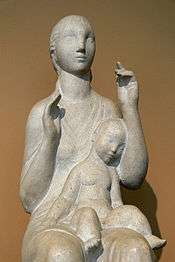 |
South Kensington London | Turner's composition "Mother and Child” now in the Victoria & Albert Museum dates from 1936 and was given to the Victoria & Albert by Miss Jessica Turner one of Turner's daughters.[2] |
Notes
- In Tate Britain Archive there is a copy of the agreement dated 13 June 1905 between Turner and the Sheffield authorities. Turner was paid £ 3000 for his work. Thomas Brock was named in the agreement as one of two sureties.[3]
References
- Alfred Turner Biography Mapping the Practice and Profession of Sculpture.Retrieved 25 August 2012.
- Ashmolean Museum catalogue. For Exhibition that ran from 21 June to 2 October of 1988. Oxonian Rewley, 1988. ISBN 0-907849-79-2.
- Collection TGA 8713 to TGA 8713/3 – Alfred Turner. Tate Britain archives.
- Tynemouth British Listed Buildings. Retrieved 26 August 2012.
- Images of: Queen Victoria by Alfred Turner. Date: 1905. Location: Endcliffe Park. Sheffield Hallam University. Retrieved 24 August 2012.
- "E R Mobbs DSO Allegory" UKNIWM. Retrieved 25 August 2012
- Fulham. UKNIWM. Retrieved 25 August 2012.
- Kingsthorpe. UKNIWM. Retrieved 25 August 2012
- Radyr Allegory. UKNIWM. Retrieved 25 August 2012.
- Sir Galahad, Victoria College. Société Jersiaise. Retrieved 25 August 2012.
- Wykehamists – WW1 and WW2. UKNIWM. Retrieved 25 August 2012.
- Dreams of Youth Mapping the Practice and Profession of Sculpture in Britain and Ireland 1851–1951, University of Glasgow History of Art and HATII, online database 2011. Retrieved 25 August 2012.
- "Psyche" Mapping the Practice and Profession of Sculpture in Britain and Ireland 1851–1951, University of Glasgow History of Art and HATII, online database 2011. Retrieved 25 August 2012.
- Constable Mapping the Practice and Profession of Sculpture in Britain and Ireland 1851–1951, University of Glasgow History of Art and HATII, online database 2011. Retrieved 25 August 2012.
- The Hand Mapping the Practice and Profession of Sculpture in Britain and Ireland 1851–1951, University of Glasgow History of Art and HATII, online database 2011|accessdate= 25 August 2012.
External links
| Wikimedia Commons has media related to Alfred Turner. |